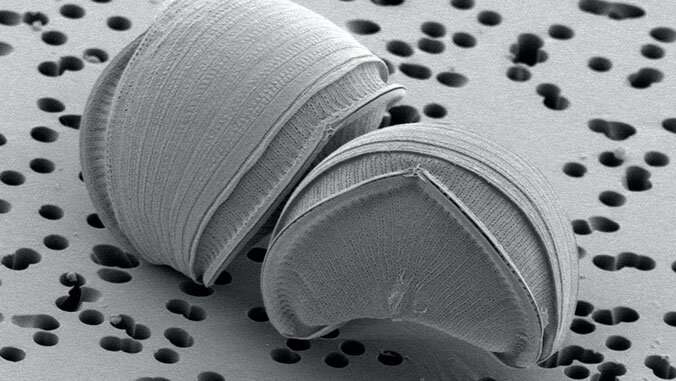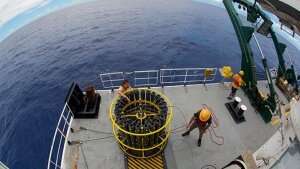New marine phytoplankton species have symbiont that produces their 'fertilizer'

The discovery of two new and unusual species of diatoms (phytoplankton) in Hawaiian waters was announced by a team of University of Hawaiʻi at Mānoa researchers in the Department of Oceanography's Center for Microbial Oceanography: Research and Education (C-MORE), along with collaborators at the University of California Santa Cruz, and California State University San Marcos. The organisms were also found to fix nitrogen, a critical process that converts gaseous nitrogen into a form that supports productivity in the nutrient-poor open ocean they inhabit. The findings were published in Nature Communications.
Diatoms, with their intricately patterned cell walls made of glassy silica, are some of the most well-known and charismatic phytoplankton. They fare best in nutrient-rich conditions. In the nutrient-poor open ocean waters around Hawaiʻi, diatoms struggle to acquire enough nitrogen to grow.
To solve this problem, some diatoms have established symbiotic relationships with nitrogen-fixing cyanobacteria. These special endosymbiotic cyanobacteria can take dissolved nitrogen gas—which is plentiful in seawater but not accessible to the diatoms—and convert it into ammonia, a form of nitrogen that the diatoms can easily use, but which is otherwise exceedingly sparse in the open ocean. By harboring the cyanobacteria inside their glass houses, diatoms have their own personal nitrogen generators. They become a self-fertilizing system.
Revealing the nearly invisible
"Oceanographers have known about these diatom-cyanobacteria symbioses in waters around Hawaiʻi for many years, but the species we discovered are something quite different," said Christopher Schvarcz, C-MORE researcher and the lead author on the study.

The better known examples of these types of symbioses are very easy to spot under the microscope, because the diatom hosts are large "centric" cells with radial symmetry, and the endosymbiotic cyanobacteria living inside them form chains of cells that emit a bright yellow-orange fluorescent glow when illuminated with blue light.
The new diatom species isolated by Schvarcz are smaller and belong to a different lineage with an elongated shape with bilateral symmetry. Their symbionts are also smaller, unicellular and do not glow under fluorescent light because they do not contain chlorophyll, making them nearly invisible inside the diatom. This likely explains why they had gone undetected for so long. Schvarcz discovered the new species by adding samples of seawater to nitrogen-poor growth medium in the lab, then carefully examining the cultures under a microscope over a period of weeks and months to see what sorts of phytoplankton would grow.
"The results were a surprise," said Grieg Steward, a UH Mānoa professor who worked with Schvarcz on the project. "The new diatoms are related to species found in freshwater. We had no idea we would find their cousins thriving far out in the open sea. Chris's work is an important reminder of how much one can still learn with a little patience and careful observation."
Finding unusual patterns
Another surprise came when the team measured the daily patterns of nitrogen fixation of the cultures. Species that had been studied previously tend to concentrate their nitrogen fixation activity either during the day or at night, but not both.
"With these new species, we found an unusual hybrid pattern," said Sam Wilson, a researcher in C-MORE who led the effort to measure the nitrogen fixation rates of the cultures using custom-built equipment. "These cells fix nitrogen starting in darkness around midnight and continue all the way through the morning, afternoon and into the early evening. Then they take a six-hour break around sunset. We don't know why they do this yet, but finding this odd pattern is exciting, because it means we are about to learn something new about an old process."
More information: Christopher R. Schvarcz et al, Overlooked and widespread pennate diatom-diazotroph symbioses in the sea, Nature Communications (2022). DOI: 10.1038/s41467-022-28065-6
Journal information: Nature Communications
Provided by University of Hawaii at Manoa





















